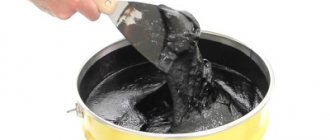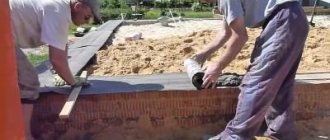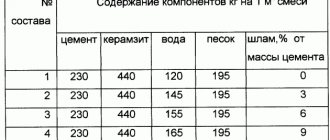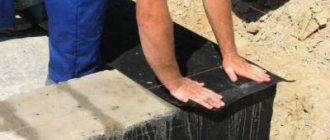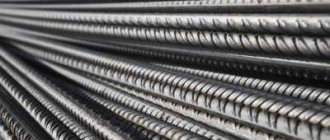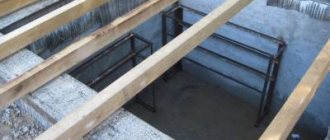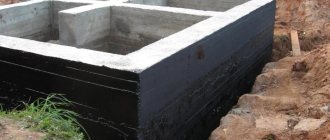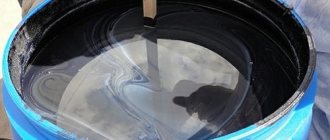Rolled waterproofing materials these days are often replaced by modern coating mixtures, since concrete absorbs liquid solutions well. Mastics have a viscous plastic consistency, due to which they firmly bind to the base and form a single whole with it.
Purpose and application
The use of waterproofing mastic prevents premature destruction of structures in direct contact with water or exposed to aggressive factors. When operating foundations, roofs, basements, communications, underground garages, floors, and hydraulic structures, the following negative phenomena are possible:
- seepage of groundwater through micropores;
- cracking and shedding of material destroyed due to thermal expansion and precipitation;
- the appearance of cracks during shrinkage of buildings.
Bitumen and polymer waterproofing helps prevent water from penetrating into the concrete structure, creating a moisture-proof protective film on the surface. When choosing impregnation, take into account the following characteristics:
- water resistance to tearing (for basements and ground floors) and pressure (concrete experiences similar loads in pools and tanks);
- resistance to cracking under dynamic stresses;
- adhesion indicators;
- ease of use, can be applied to wet concrete;
- reliability, service life.
What is it, properties and composition
The term “mastic” refers to semi-liquid compositions applied to the surface of the foundation without the need for additional rigid reinforcement in order to obtain a moisture-impermeable layer and protect structures from destruction.
The basis of the material is bitumen binder (black petroleum bitumen BN70/30 or modified alloys of various grades), fillers and aqueous or organic solvent. The general properties of mastics include the ability for uniform distribution and high adhesion.
Scope of application
Foundation mastics are intended for:
Obtaining a full protective layer when carrying out external or internal waterproofing of structures in contact or buried in the ground up to 5 m.
These include foundations of any type, floors, walls of basements and garages, and plinth strips. The exact purpose depends on the brand; the range includes both universal and specialized formulations.- Installation or repair of rolled waterproofing materials, including on vertical surfaces. Coating the panels with mastic eliminates the formation of voids between the layers and makes the protection monolithic.
- Preparation of foundations for the installation of other hydro- or heat-insulating materials.
The thickness of the waterproofing layer depends on the depth of the foundation. When protecting structures with a depth of up to 3 m, at least 2 layers of mastic are applied to the surface with a total layer thickness of 2 mm, 3-5 m - 2-4 layers with a thickness after drying of 2 to 4 mm.
Advantages and disadvantages
The advantages of such compositions include:
- Creation of seamless, highly adhesive, waterproof, durable and sufficiently elastic coatings that follow the contour of any type of foundation. The need for reinforcement arises only in difficult areas - joints of structures, corners or over possible cracks.
- Ease of application, relatively high speed of waterproofing work.
- High resistance to biological factors, temperature changes and ultraviolet radiation.
- Filling small pores and voids in concrete.
- Simplification of subsequent thermal insulation work. Insulation boards adhere more easily to a slightly sticky surface; when using grades without toxic solvents, the mastic does not destroy the structure of expanded polystyrene and allows you to create monolithic protection.
The disadvantages are:
- Strict requirements for the condition of treated surfaces and work conditions. Applying mastics to wet, weak, icy or dirty substrates is considered a gross violation of technology.
- Increased consumption on uneven surfaces (including masonry) and the likelihood of rupture of coatings in the presence of sharp protrusions or cavities.
- Relatively high water absorption of the formed bitumen coatings.
Even for the best brands, this figure varies from 0.5 to 4%; such water protection is not designed for constant moisture resistance. As a result, when the depth of structures is more than 2-5 m (the exact value depends on the type of mastic and the parameters of the site), construction is carried out on aggressive soils and there is a high risk of foundation flooding (groundwater level above 1.5 m), another method of waterproofing the foundation is chosen. In particular, mastic is combined with rolled materials. - The need to monitor the thickness and uniformity of applied layers (in particularly important cases, with control by a probe) and their drying time. Also, when working with modern formulations, it is important to check their release date and storage conditions.
In general, the advantages prevail: when operating the foundation under standard conditions, mastic is considered the optimal waterproofing material in terms of price and reliability.
Popular sealants for sealing joints in concrete
Compositions for sealing concrete structures can be manufactured in accordance with GOST 25621-83 “Polymer construction materials and products for sealing and sealing”, or according to specifications developed by manufacturers.
The list of sealing materials that have proven themselves on the Russian market includes:
- Parabond Construction is a one-component polyurethane sealant for sealing joints in concrete. The consistency of the material allows you to fill seams of any type - horizontal and vertical, connecting, movable. Suitable for exterior and interior use.
- Dow Corning 791 is a non-shrink, one-component, silicone-based sealant material. Designed for outdoor use, for filling joints prone to movement.
- Accent 117 is an acrylic one-component sealant. This is a non-shrinkable, frost-resistant material for sealing expansion and interpanel joints. When hardened, it has a rubber-like structure.
Classification of waterproofing material
The division is conditional:
According to the method of installation and readiness for use, hot and cold applied compositions are distinguished; the former require heating to at least 190 ° C and special equipment, the latter can be one- or two-component.
In private practice, the most in demand (up to 95% on the market) are ready-to-apply one-component cold mastics that do not require mixing with other materials.- Based on the type of base, there are water-based products and brands diluted with organic solvents.
The former are valued for their ease of application (including by mechanized means), accelerated and complete hardening, environmental friendliness and safety. The latter can be used at sub-zero temperatures, but are considered more dangerous when applied and dried. In particular, if it is necessary to waterproof basements in use, solvent-based mastics are abandoned in favor of water-based ones, or the resulting coatings are subsequently covered with other materials. - According to the composition and type of filler, there are mineral-based bitumen mastics (with the addition of cement, chalk, ash, peat chips or asbestos), emulsions (aqueous solutions with finely ground modified bitumen, applied in 4-5 layers or used in preparing the foundation for insulation work ) and complex compositions with additives of polymers and rubber. The latter are more expensive, but benefit from elasticity and water resistance.
Types of mastics for insulating building structures
Type of polymer mastic
This material is a plastic adhesive substance that is used to protect against moisture, and also as an independent binding material for surfaces. Such waterproofing is considered an effective and multifunctional product, since it does not require additional preliminary finishing or plaster and is quite simple to use.
There are two main types of mastic:
- Bitumen mastic. This is a substance that contains petroleum products. It is a thick, black, homogeneous mixture with a high level of density. It is most widely used in sealing foundations, basements and basements, as well as in rooms with high levels of humidity (bathroom, laundry room, toilet). This material does not tolerate direct sunlight and when heated turns into a more liquid state. Bitumen needs additional protection. Basically, a layer of earth is poured onto its surface, decorated with decorated stone masonry, or additional insulation is used.
- Polyurethane mastic is a multifunctional, improved, in comparison with bitumen substance, mixture of acrylic components. It is not afraid of heating, does not lose its original shape and structure, and does not contain toxic by-products. Also, this material can act as an independent insulation, since due to its structure it is able to retain and accumulate heat.
Common brands
The best indicators and user reviews have:
- all lines of TechnoNIKOL mastics;
- cold bitumen mastics Grid, in particular a specialized brand for foundation waterproofing - MGH-G;
- Icopal waterproofing mastic – a composition based on high-quality bitumen and solvent with the addition of corrosion inhibitors and antiseptics;
- Bitumast – mastic for coating waterproofing of foundations, compatible with almost all bitumen and bitumen-polymer materials;
- Suho Izowax is a water-based cold mastic.
Bituminous waterproofing GOST
Various waterproofing and roofing bitumen products have uniform standards and technical conditions that determine the following points:
- Requirements for raw materials and materials;
- Marking;
- Package;
- Safety requirements;
- Acceptance rules.
On our website you can download the current edition of the relevant GOST standards by clicking on the following link - Waterproofing mastics GOST 30693-2000.
Which one is better to choose?
Preference is given to ready-to-apply waterproofing mastics for foundations and floors that can withstand short-term exposure to water under pressure in excess of 0.003 MPa and have minimal (ideally no more than 1-2%) water absorption rates after drying.
When choosing a specific brand, the following are taken into account:
adhesion indicators with concrete and rolled materials (the higher they are, the better);- declared consumption and proportion of dry non-volatile substances in the mastic residue;
- heat resistance of the mastic (ideally above 100 °C, but not less than 70);
- appearance and weight of the composition - high-quality mastic has a uniform plastic structure and weighs less than water, in practice this means that its weight should not exceed the volume of the container; heavier, cheaper brands crack faster and collapse after 1-2 years.
Specialized brands TechnoNIKOL and Grida MGH-G meet these requirements. The use of universal mastics (essentially roofing mastics) is permissible only on dry, non-aggressive and permeable soils, shallow foundation depth and low groundwater level.
Video: polyurethane mastic for roof repair
Mastic is a seamless, seamless waterproofing that creates a powerful waterproof layer and protects building surfaces from the destructive effects of moisture. If you are looking for a universal finishing agent that can act as an independent insulating layer, and also have the additional function of a decorative agent, then this material will more effectively cope with the tasks.
This is an environmentally friendly and safe substance that will protect the monolithic structure from the effects of water and its derivatives, thereby extending the life of your building.
Preparing the foundation surface
When preparing the foundations, sequentially:
- The strength and moisture content of the hardened concrete is checked. It is recommended to start waterproofing work at least a month after concreting. When working with old bases, the surface is cleaned of weak and flaking particles, all possible cracks are covered with a solution and reinforced with fiberglass mesh.
- The evenness of surfaces is checked and possible imperfections are eliminated. At this stage, sharp protrusions larger than 2 mm will be removed or hidden, and masonry joints and cracks will be covered. Problem areas and joints are reinforced with mesh if necessary.
- The foundation walls are cleaned, dusted, treated with primer or antiseptic primer and dried well.
Impregnation of concrete with primer is an optional, but important action aimed at reducing mastic consumption and improving the quality of its adhesion. If there are no other insulating layers, this work should not be skipped; expensive primers can be replaced by the same mastic in diluted form.
Execution of work
Mastics are applied in the manner recommended by the manufacturer and distributed with brushes, a spatula or a roller.
Among the main requirements of the technology are:
Carrying out work under conditions permitted in the instructions. Particular attention is paid to the temperature of the air, the base and the mastic itself; even “winter” types cannot be applied to a frost-covered foundation.- The need for uniform distribution of the composition, the absence of unpainted areas or drips.
- Monitoring the thickness of applied materials after each layer has dried.
- Allow each applied layer to dry completely.
Long breaks in waterproofing work are not dangerous, but undesirable; each layer must be applied completely. Work will be carried out using PPE, all tools and equipment will be cleaned promptly upon completion.
Installation of bitumen waterproofing - step-by-step instructions
The installation of coating or sprayed bitumen-based waterproofing must be carried out in a certain order and strictly following the instructions:
- Surface preparation. Cracks and bulges should be leveled with the main sheet; if there are concrete joints, they must be compacted in advance. Before installing the insulation, it is necessary to thoroughly clean the base on which the coating insulation will be applied. The base must be cleaned of sharp stones, deposits, dirt and dust. High-quality preparation will allow the material to cover the base well and subsequently adhere well to it. These operations should be given due attention, since if they are performed correctly, a high-quality result is guaranteed.
- Arrangement of fillets or transition fillets. To prevent fracture or static punching of the future waterproofing coating, it is necessary to install a so-called fillet at all transitions between the horizon and the vertical. The fillet can be made from cement-sand mortar of a grade not lower than m-150.
- Primer of the base (application of primer). Before installing bitumen spraying or coating mastic, it is imperative to use a primer. A primer or primer increases the adhesion of the waterproofing layer; before applying the primer, the surface on which it will be applied should be dried. If the primer will be used in a residential area, you can use an infrared heater.
- Waterproofing device from various bitumen compositions. First you need to select the right tool. The choice of working tool depends on the consistency of the applied composition. If bitumen mastic is liquid, then it should be applied using a brush or roller. The material is applied in several layers, and the thickness of the waterproofing should not exceed 1.5 mm, and each new layer is applied in a perpendicular direction to the old one. Before applying each new layer, you should make sure that the old one is completely dry, so it is important to choose the composition that will help you spend less time on it. Thicker mixtures, more like a paste, are applied by coating using a spatula, regular or notched. Thick mixtures can be applied in several layers, although sometimes you can get by with just one. Each layer should be more than 3 cm thick. The second layer of mastic is applied to the dried first one.
- After installing coating insulation, the surface must dry. During the setting of the composition, the settling of dust or any other small particles is unacceptable. After the building material has completely dried, repairs can continue.
Important: Each manufacturer has its own detailed instructions for the correct design of its materials. When carrying out work, you must carefully study the manufacturers' instructions and follow them throughout the entire process.
Price
The prices of the most popular brands (see table below) are almost the same; the estimated costs for two-layer coating of 1 m2 of foundation with them vary from 120 to 250 rubles.
| Brand name | Average consumption, kg/m2 | Capacity | Price, rubles | Average price 1 kg, rubles |
| AquaMast Foundation Waterproofing | 1 | 10 kg | 1200 | 120 |
| Grida MGH-G | 0.7-1 when applying 1 layer 1 mm thick | 2 kg | 260 | 130 |
| Icopal | 1-2 | 21.5 l | 1600 | 75 |
| Bitumast | From 0.5 per 1 layer | 2 l | 250 | 125 |
| Suho Izowax | 1.5-2 per 2 layers | 20 kg | 2100 | 105 |
Everything you need to know about foundation waterproofing can be found in this section.
